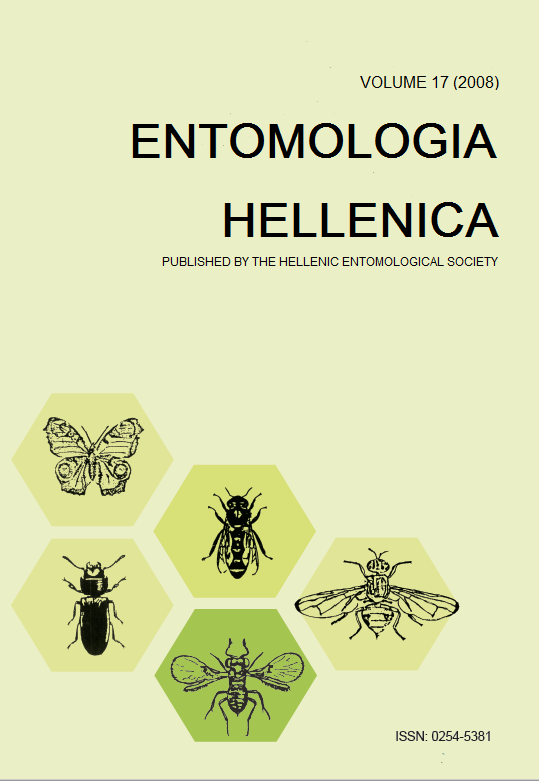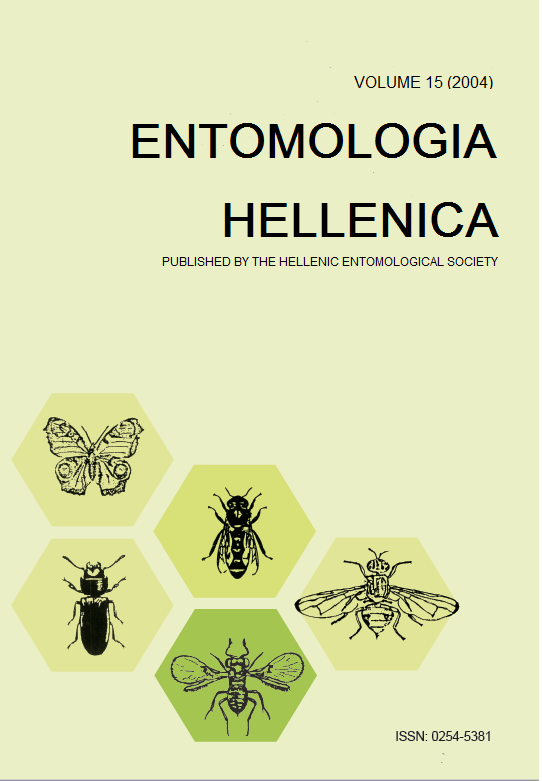Προτίμηση του Macrolophus melanotoma μεταξύ του κύριου αυτοφυούς φυτού-ξενιστή του, Dittrichia viscosa, και της μελιτζάνας, πιπεριάς και τομάτας, σε πειράματα επιλογής
Περίληψη
Στη μελέτη αυτή εξετάσθηκε η προτίμηση του αρπακτικού Macrolophus melanotoma (Costa) (=M. caliginosus Wagner) (Hemiptera: Miridae) μεταξύ του Dittrichia viscosa L. (W. Greuter) (Asteraceae), που αποτελεί το κύριο φυτό ξενιστή του, σε σχέση με τη μελιτζάνα, πιπεριά και τομάτα, καθώς και μεταξύ της μελιτζάνας, πιπεριάς και τομάτας. Τα πειράματα πραγματοποιήθηκαν σε κλωβούς όπου το αρπακτικό είχε τη δυνατότητα να επιλέξει μεταξύ δύο φυτών διαφορετικών ειδών. Σε κάθε επανάληψη, ένα ενήλικο του αρπακτικού ελευθερωνόταν είτε επί της βάσης του κλωβού μεταξύ των δύο φυτών είτε στα κορυφαία φύλλα του φυτού μελιτζάνας, πιπεριάς ή τομάτας. Η θέση του αρπακτικού καταγραφόταν μετά από 20min, 1, 2, and 24h από την ελευθέρωσή του στον κλωβό. Σύμφωνα με τα αποτελέσματα, το Μ. melanotoma έδειξε υψηλή προτίμηση για το φυτό από το οποίο προερχόταν, δηλαδή το D. viscosa, σε σχέση με το φυτό μελιτζάνας, πιπεριάς ή τομάτας. Μεταξύ των τριών σολανωδών φυτών είχε σχετικά μεγαλύτερη προτίμηση για τη μελιτζάνα. Επομένως, το M. melanotoma φάνηκε να μην προτιμά την τομάτα και την πιπεριά, όμως θα πρέπει να μελετηθεί περαιτέρω η δυνατότητά του να αποικίζει καλλιέργειες μελιτζάνας.
Λεπτομέρειες άρθρου
- Πώς να δημιουργήσετε Αναφορές
-
Lykouressis, D., Perdikis, D., & Kallioras, C. (2012). Προτίμηση του Macrolophus melanotoma μεταξύ του κύριου αυτοφυούς φυτού-ξενιστή του, Dittrichia viscosa, και της μελιτζάνας, πιπεριάς και τομάτας, σε πειράματα επιλογής. ENTOMOLOGIA HELLENICA, 21(1), 3–12. https://doi.org/10.12681/eh.11513
- Τεύχος
- Τόμ. 21 Αρ. 1 (2012)
- Ενότητα
- Articles

Αυτή η εργασία είναι αδειοδοτημένη υπό το CC Αναφορά Δημιουργού – Μη Εμπορική Χρήση – Παρόμοια Διανομή 4.0.
Authors who publish with this journal agree to the following terms:
Authors retain copyright and grant the journal right of first publication with the work simultaneously licensed under a Creative Commons 4.0 license.
Authors are able to enter into separate, additional contractual arrangements for the non-exclusive distribution of the journal's published version of the work (e.g. post it to an institutional repository or publish it in a book), with an acknowledgement of its initial publication in this journal. Authors are permitted and encouraged to post their work online (preferably in institutional repositories or on their website) prior to and during the submission process, as it can lead to productive exchanges, as well as earlier and greater citation of published work.





